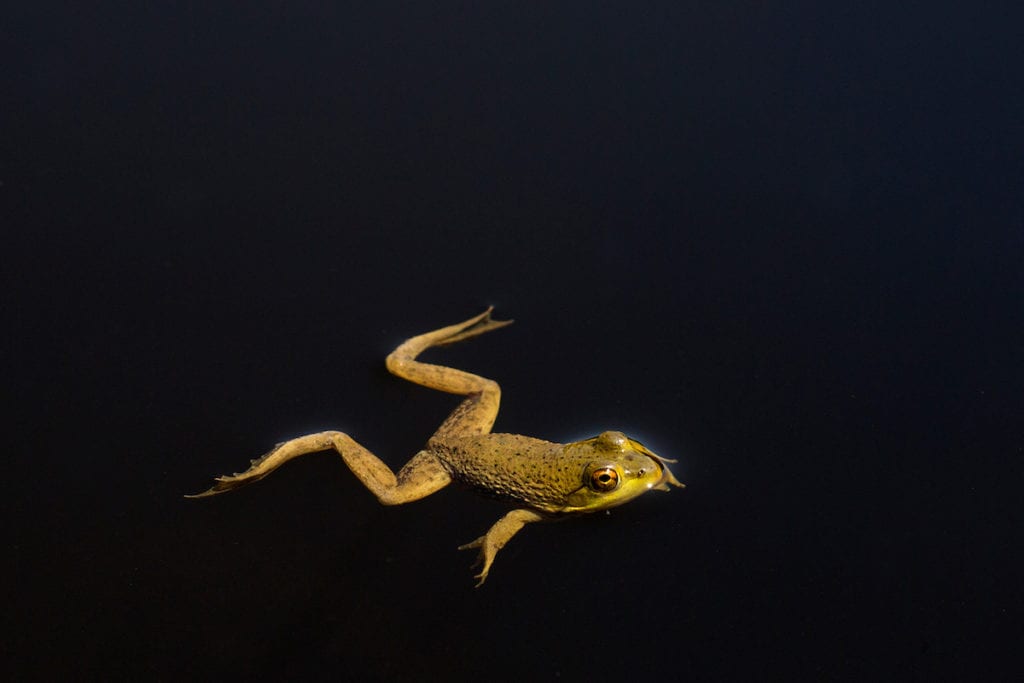
The pond was busy today. Tucked in a high knoll between Bald and Penobscot Mountains, surrounded by hillsides of grainy rock ledges and a waterfall of trees, the breeze skirted across the water and cooled my hot hiking body. The early afternoon sun was brilliant, so I sat in the shade to enjoy the view.
Water bugs were swirling in unpredictable patterns right in front of me, swimming first on top of and then below the water’s surface, sometimes mistakenly knocking into one another. Thin fresh beaver sticks had collected in a ring around the pond and in every nook of the pond, the bright green leaves of the floating branches rising above the water’s surface. I searched the entire perimeter of the pond for a lodge but didn’t see one — perhaps it was tucked into the far cove. I kept hoping I would see or hear the beaver but never did.
Dozens of dragonflies and damselflies were flying madly over the water, weaving their way through the air and in among the overhanging shrubs at the edge of the pond. A hatch was on! So many flying all at the same time. Not just one species, but several — four different dragonflies and one damselfly.
The damselflies were thin and bright blue, the dragonflies fat by comparison, each sporting a different color — one blue and black, one red-orange, another camouflage brown, and a lone multicolor very much larger than the others. I watched several flying about intertwined in mating and then saw the female lay her eggs, moving slowly over the water’s surface, repeatedly dipping the end of her tail atop the water with the male still hanging on.
A Blue Jay and giant-looking robin were poking around at water’s edge, making loud calls, hopping and flying about, dipping their toes and bills into the water. I was curious as to why they were there. At first I thought they had come for a drink, but they kept flying off into the shrubs, then circling back to the water. The robin flew off to perch on a dead tree branch overhanging the pond, dashed out into the air, then landed back on the tree branch — acting just like a flycatcher. How peculiar! The jay stepped gingerly on the emergent pond plants, reached out as far as he could without falling in, then retreated. A red-winged blackbird joined them, flying through the heath shrubs aside the pond, dipping and rising along its flight path.
Suddenly it dawned on me: They were all stalking the dragonflies! Taking advantage of this ephemeral bonanza while it lasted.
All around the pond I heard the banjo call of four individual Green Frogs each defending his territory. First one, then another, their calls rarely overlapping. Yellowthroat Warblers called from the thick ericaceous shrubs at the water’s edge. I could easily picture their bright yellow breast and black eye mask hiding behind the leaves, taunting me to find each one with his “witchitty witchitty witchitty” song. A Swamp Sparrow added his low ringing trill to the yellowthroats from amid the tall shrubs, and from the woods beyond the pond I heard the loose trilling of a junco from high in a tree, a White-throated Sparrow saying “here sam peabody peabody peabody…” echoing from amidst the shrubs underneath, and a Black-and-white Warbler’s squeaky wheel running in circles.
The day was hot. All around the pond, sphagnum moss was drooping over the edge of the water. Usually bright green or red and filled with stored moisture, this moss was all dried up and a dull yellowish green in color. So dry so early in the year. Above the dried moss rose bushes of blueberry, huckleberry, rhodora, and winterberry, with a few stunted black spruce sprinkled in. The pink flowers of the rhodora were falling apart — the bees long gone — decorating the ground with their pink petals, and upon close inspection the blueberries and huckleberries already had tiny green berries hanging in small clumps from their branches.
The shrubbery formed a thick, impenetrable tangle above the lumpy damp ground that I know from experience would be nearly impossible to walk through. Yet in the coming months these shrubs will offer a different food bonanza for the birds and other wildlife (like bears!) to gorge on. Wouldn’t it be fun to come back and see who finds them?
